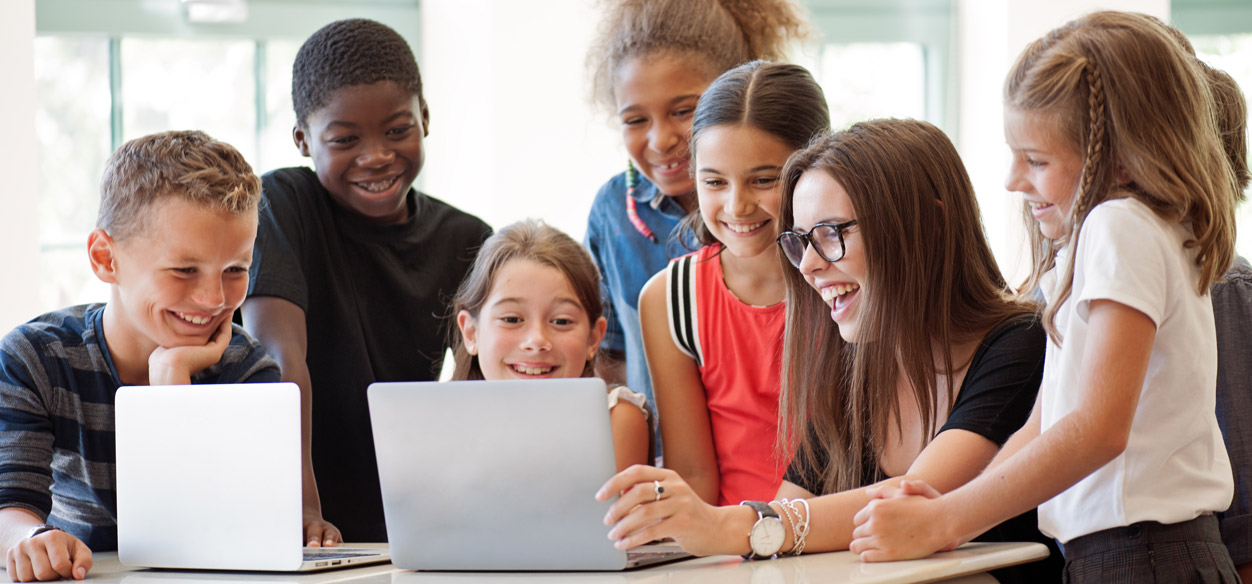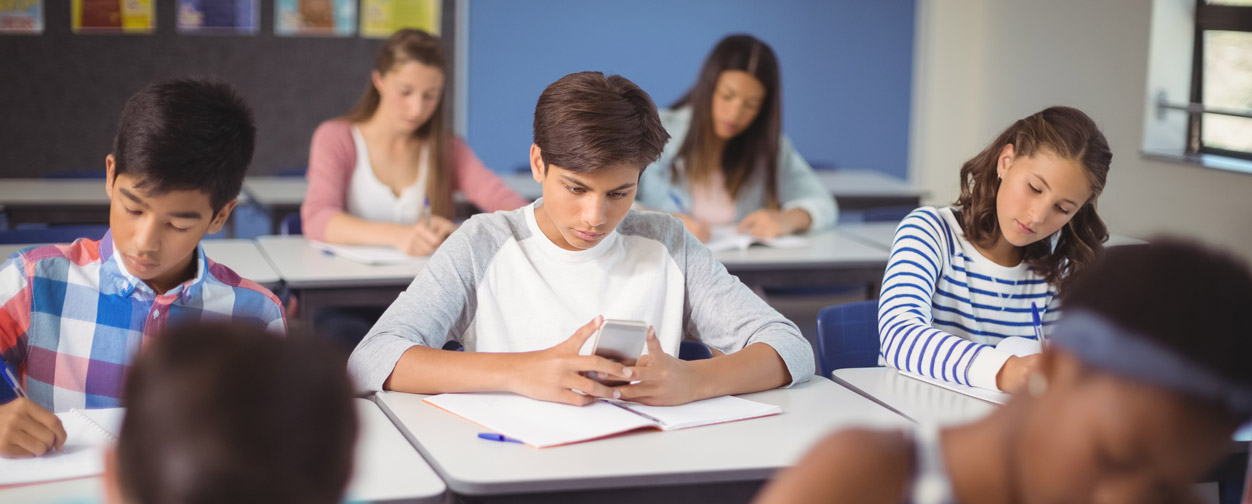How to Use the Internet Correctly as a Student
As an educator, it's important to recognize that children in modern times are surrounded by technology at school. Whether they have a cell phone in their pocket or require a computer to complete in-class assignments, the internet is available everywhere. When you are setting up your classroom for the new year, consider educating your students on how to be safe while exploring the internet.
You'll need to understand the meaning of online safety, learn about online child safety laws and find out how you can educate your students on the importance of staying safe online.
Internet Safety & Kids
- 70% of 8-17 year olds admitted to seeing images and videos not suitable for their age in the last year
- 23% of 8-17 year olds admitted that they didn't know how to control who can see their social media profiles
- 29% of parents allow their children to use the internet without restriction or supervision
What Is Online Safety?

While this broad term can be thrown around a lot, the true meaning behind online safety is keeping your students safe online while still allowing them the freedom to use the internet. Teachers must find a balance between ensuring online safety and allowing students to explore the resources the internet has to offer. Keeping your students safe online includes informing them of the risks and drawbacks of the web, while also encouraging the benefits. Since many educational programs and homework assignments rely on the internet, it's crucial students know what makes a website off limits.
Online Safety is not:
- Overbearing internet monitoring
- Enforcing excessive online restrictions
- Limiting internet usage
- Forbidding students to hold social media accounts
Online Child Safety Laws
In order to understand how to keep your students safe online, you'll want to become familiar with online child safety laws. These can help you find the right websites to incorporate into the classroom and ones to stay away from.
Children's Online Privacy Protection Act (COPPA)
The main law regulating children's online safety is known as the Children's Online Privacy Protection Act or the COPPA. The act has been in place since 2000, and was updated in 2013. It puts parents in the "driver's seat" of what their child of up to 13 years views online by requiring parental consent for the collection or use of any personal information of young website users.
Where does this come into play for educators? The COPPA has placed requirements on the operators of websites that are either directed to children under 13 or that have knowledge that they are collecting personal information from a child under 13 years of age. This means that limiting kids to websites covered by COPPA can greatly improve their safety.
Websites covered by COPPA include:
- Websites directed toward general audiences but collect personal information (i.e. a website asking for a user's birthday or zip code)
- Third-party services like an ad network or plug-in collecting information from users of a site/service directed to children under 13
- Website/online service directed to children under 13 and collects personal information from them
Flaws with COPPA:
- Children can manipulate sites by adding a birthday that is over 13
- Teens 14-17 are not protected and still legally a minor
- Websites do not have a reliable way to obtain parents' consent online
- Websites do not have an effective way to authenticate a child's age
Websites covered by COPPA must post privacy policies, provide parents with notice of information practices and collect parental consent before collecting a child's information. However, there are quite a few flaws with this act to keep in mind.
While COPPA is effective for some instances, children are still vulnerable to sensitive material such as graphic violence, sexual content and profanity, as well as cyberbullying. Read below to find out how you can keep your students safe and how you can educate your students to browse the web safely.

Kid-Friendly Websites Verified by COPPA
Children's Internet Protection Act (CIPA)
The Children's Internet Protection Act (CIPA) went into place in December 2000. It states that no school or library can receive E-rate discounts for internet access unless the school/library certifies it is enforcing an internet safety policy. The internet policy must include the use of filtering or blocking technology and protect against access to graphics that are obscene, include child pornography or are harmful to minors.
CIPA Requires an Internet Safety Policy Addressing:
- The safety and security of minors when using direct electronic communications
- Unauthorized disclosure, use and distribution of personal information regarding minors
- Access by minors to inappropriate content online
- Rules that restrict minors access to harmful materials
Flaws with CIPA:
- A student can simply ask a librarian to unlock a blocked site
- A student does not have to explain why they are asking for a site to be unblocked or for the filtering to be disabled
- You cannot import your own block lists of websites to avoid
- CIPA does not require the tracking of internet use by minors or adults
CIPA has benefits that can prevent a child from seeing inappropriate content, but the ability to unblock any website makes this act flawed. Be mindful of what students are asking you to disable. As stated above, a major flaw with CIPA is that teachers cannot create their own block lists. This is because the websites blocked are preset and teachers have little control of what websites are qualified as inappropriate. While you can't create your own block lists of websites to avoid, make it clear that visiting unauthorized websites can be incredibly dangerous and is against the rules.

Educating Students On Online Safety
1
Integrate online activities.
Rather than giving students time to write in their journal, have them set up a blog monitored by you. If they are under the age of 16, it's recommended they use a pseudonym and refrain from adding any personal details such as address and birthday to their blog.
Topics to discuss can include what they want to be when they grow up, a funny story from when they were younger, or something they are passionate about. Ross Cooper, an elementary principal makes a valid point that we would be hypocritical to say we'd practice digital citizenship, but refuse to allow students to practice it.
2
Create a student pledge.
A media pledge is a great way to hold students accountable for online safety in the classroom after they have been educated on the topic. As a class, come up with about 10 rules that you and your students promise to practice safer internet use. These can include what to post online, what to share online, and anti-bullying rules. Write them on the whiteboard, then get the rules printed and laminated to hang up in the classroom. Have your students repeat the rules out loud every month or so. Below are a few examples of internet safety rules based on grade levels.
Rules for Elementary School
- I will tell a parent or guardian if something online makes me feel sad, scared or uncomfortable
- I will never meet face-to-face with anyone from the internet
- I promise to be kind online and use proper netiquette
Rules for Middle/High School
- I agree to think before I post and never post content that may put me at risk or ruin my future (e.g. inappropriate images or messages, vulgar language or my home address)
- I will always inform a parent or guardian when meeting a friend online and meet in a public place with a parent or guardian
- I will respect people online. I will not say or post anything offensive or threatening and will never harass and embarrass anyone by posting inappropriate content
3
Discuss digital footprints.
Students need to understand that any information and activity they put out on the web can come back to haunt them/become public. Online information is almost impossible to completely get rid of once out there. We recommend your students take Capella University's free Digital Citizenship course to get a feel for their online profile. It will ask students what kinds of online activities leave digital footprints, what would you find if you Google yourself and more.
4
Remember the golden rule.
When it comes to interactions online, students tend to forget that their words are just as effective online as they are in person. Remind them that the words they choose make an impact on the receiver, even if it's just a joke or unintentional. Explain that everything they say online they should honor as if they were speaking the words out loud. Treat others the way you want to be treated on and off the screen. A good strategy is to place a poster in the classroom or install a desktop background that repeats this message, so students are reminded of how to properly speak to others online.
5
Present real-life situations.
Create real-life situations for students to consider, discuss and learn from. Telling a story can be more effective than just listing the dos and don'ts of browsing the internet. This is best for high school students, where they can watch a short clip or hear a story and understand the consequences of such situations. You may want to include the backlash of posting an inappropriate photo, what to be aware of in a chat room, or the real-life drawbacks and consequences of going on inappropriate sites at school. Students can relate and reflect on these issues, and may then feel comfortable sharing their own online experiences.
6
Involve parents or guardians.
When it comes to kids, parents' approval is everything. Because many of your students will not want to disappoint their parents, educating parents on online safety is key to keeping students safe. Let them know the dangers of inappropriate internet usage and ask parents to create an open and honest conversation with their child.
Advise them to bookmark safe, COPPA kids sites for young children so they have a set list of sites to visit. In the classroom, let them know that their internet activity at school may be shared with their parents and they should only browse sites approved by them.
Create an open dialogue about internet safety and encourage parents to do so as well. Share questions like these to guide their conversations:
- What's your favorite site to visit?
- What do you enjoy doing online?
- How do you stay safe online?
- Have you ever met a new friend online?
- Is there anything you see on the internet that makes you feel bad?
- Can you teach me how to be safe online?
7
Use course management systems to communicate with students.
If your students are in late middle school or high school, use course management systems to communicate with students. Sites like Blackboard and Moodle make it simple to integrate the internet into the classroom. Use these for assigning homework, projects, and in-class assignments. This limits the need for outside communication between students online on school time.
8
Stick with websites verified with COPPA/CIPA.
Make sure the sites you visit with students are under the COPPA and CIPA compliant. These include individualized education modules such as Brain Pop, kids newspaper sites such as DOGOnews, and fun websites for rainy day/down time such as PBS Kids and Disney Junior. You can find out if they are COPPA verified by going to their privacy policy page. The website should say something like "this policy is accordance with "COPPA" and should also have a certified badge.
If they are not verified with these two acts, spend time auditing the site, keeping an eye on pop-up ads, questionnaires asking for information or any other questionable content. Another indicator of an okay website? Download the MOZ bar, a free tool that calculates the domain authority of a site. If it's above 75 and looks kid-friendly, it's probably okay.
9
Make internet safety fun.
Why should internet safety be a snooze? In the modern age, there are many tools for students to become informed and aware of what to expect when browsing the web. Google's Interland is a great resource that doubles as a fantasy game with video game graphics and questions and answers relating to cyber safety. The "villains" in the game pose as users' friends or family members, or ask them to give them personal information. The game also gives kids incentive to do the right thing by distributing points to those who "do the right thing."
10
Keep your profile clean.
As an educator, it's essential that you maintain a flawless social media presence. Keep all profiles private and ensure that your profile is clear of any photos containing alcohol, inappropriate language or content. Also be mindful of adding students, we recommend that if necessary, accept student friend requests only after the student has graduated high school.
Managing Student Smartphone Use

- 25% of 8-11 year olds have a social media profiles
- 75% of 12-15 year olds have a social media profile
- Nearly 50% of teens share their photos online
- 57% of children have made friends through the internet
While it's impossible to manage what your students' do on their smartphones, you can limit the use of them while they're under your wing. A general rule of thumb is to have them powered off and out of site, but because they are glued to students, suggest they stay in the backpack and only accessed during lunch hour and after school. For children in elementary school, make it a rule to keep the phones out of sight until school gets out. Although the phone is powered off or supposed to be powered off during school hours, you should still inform your students about internet etiquette and safety.
Let them know that your your personal information should always be kept private. An acronym great for remembering this, is YAPPY. This includes Your full name, Address, Phone number, Passwords, Your plans. These details should never be accessible online. Let students know that they should never give out their password, and double check with an adult if they've received an unfamiliar email asking them for information. The general rule of thumb for secure passwords is 14+ characters, no words or phrases or important info included (aka birthdays, hobbies). For more information on password protection, click here.
Smartphone Tips for Students
- Never share personal information like your address, passwords, phone number
- Only add people you know
- Never publish anything you wouldn't want family or future employers to see
- Balance screen time with green time
- Be polite online
- Keep your phone out of reach during school hours
Cyberbullying Prevention Tips for Kids
Over the past 10 years, cyberbullying has almost doubled from 18% to 34% from 2007 to 2016. Although there are many efforts to combat cyberbullying, the number increases each year, with over 85% of youth having witnessing cyberbullying in action. These numbers are frightening, and as a mentor and a teacher, it's crucial that you discuss cyberbullying and ways to maintain a safe digital environment. Below are tips you can give to your students to follow.
- Think before you share. Pause and think about if you are hurting or embarrassing someone else.
- Speak up. When you notice a classmate engaging in cyberbullying, speak to a trusted adult for help.
- Be respectful. When using a chat room or posting on a public platform, be mindful to respect others and treat others the way you want to be treated.
Also remind parents that it is illegal for a child under 13 to have Facebook, Instagram, and Snapchat profiles. However, many lie about their age and create one anyway. What's even scarier is that 23% of children don't know how to control who can see their social media profiles. Assure parents have an open conversation about social media safety and the privacy settings if their child has a profile, and make sure it is set to private.
Additional Helpful Resources
When in doubt, turn to the internet for more helpful tools to keep your students and yourself safe online. These are helpful resources that can help you make your own online safety lesson plan.
Follow our internet safety tips for the upcoming school year to ensure your students stay safe and secure when browsing the web. Create an open discussion with students to let them know they are always welcome to discuss any web content that may make them uncomfortable or unsure. Each school-owned device should have antivirus software downloaded and an adblocker to ensure secure web browsing.
- children
- education
- Internet safet
- Online safety
- students
- teeenagers
Panda Security specializes in the development of endpoint security products and is part of the WatchGuard portfolio of IT security solutions. Initially focused on the development of antivirus software, the company has since expanded its line of business to advanced cyber-security services with technology for preventing cyber-crime.
How to Use the Internet Correctly as a Student
Source: https://www.pandasecurity.com/en/mediacenter/family-safety/internet-safety-for-kids/